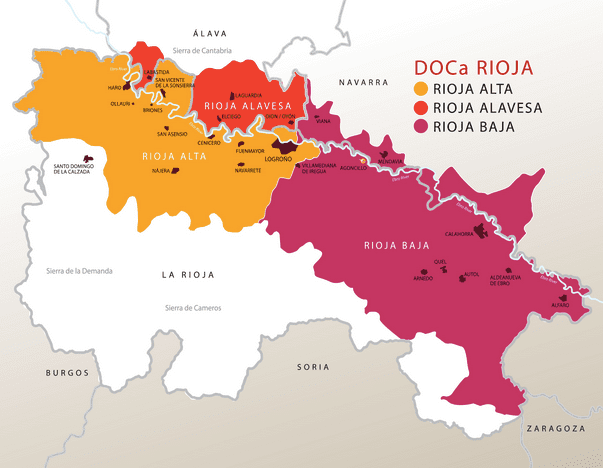The Rioja Qualified Denomination of Origin is one of the oldest and most important wine regions of Spain and the entire world. Comprised of 144 municipalities, it is located in the North of Spain, occupying lands in 3 autonomous communities, La Rioja, Navarre and the Basque Country, as well as a municipality of Castilla y León.
With the river Ebro crossing through it, historically, La Rioja is divided into three subareas, Rioja Alavesa, Rioja Alta and Rioja Baja or Rioja Oriental. Thanks to the different geographical features of the region, the diversity of soil types and the climate differences, each one of them has a unique character, transmitting all its peculiarities to Rioja wines and giving them the unique personality of each area.
Rioja Alavesa
Located north of the Ebro river, in the province of Álava, the climate in this area is continental with a Mediterranean influence as it is very well protected by the mountain range Sierra Cantabria. The soils in this area are mostly clayey-calcareous, resulting in fresh wines of moderate alcohol content and a good acidity. As in all of La Rioja, the most cultivated grape variety in the area is the Tempranillo, ideally mixed with Graciano (of low yields), Mazuelo and Red Grenache, and with white varieties such as Viura and White Grenache found in co-planted vineyards.
Traditionally, La Rioja Alavesa has stood out for its young, harvester’s wines, with carbonic maceration, also producing wines with more body and a good acidity, with good ageing capacity.
Featured wineries: Marqués de Riscal, Ysios, Valdelana, or El Fabulista.

Rioja Alta
Rioja Alta stretches south of the Ebro River, from Haro to Logroño. Here we find 42% of the total vineyards in D.O.Ca. Rioja. The climate here is continental, tempered by the mountain range Sierra Cantabria, with a great diversity of soils, generally poor in organic matter, quite limy and with good health and permeability conditions. In this subarea, although we also find Malvoisie, White and Red Grenache, Mazuelo and Graciano, the main ones are considered to be Tempranillo and Viura.
This area produces the most traditional wines, thanks to the production of wines with body, medium alcohol content and high acidity; magnificent wines for ageing.
Featured wineries: Marqués de Murrieta, Rioja Alta, Bodegas Muga, Viña Tondonia.
Rioja Baja or Rioja Oriental
To the southeast of the denomination and at about 300 metres above sea level, we find Rioja Baja (hence it’s name, Lower Rioja). Warm winds from the southeast make this the warmest of the three subareas. This matter is reflected in the harvests, which are more constant due to the absence of frost. Here we find the largest plantation areas, on generally alluvial soils, where the Grenache lives happily. Even so, the Tempranillo variety also reigns here and to a lesser extent we can also find Viura, White Grenache and Mazuelo.
The wines in this area have a higher alcohol content and more structure, although they do have less colour.
Featured wineries: Palacios Remondo, En Voz Baja, Viña Bujanda.
Explore the Rioja region with North Coast Tours
When it comes to choosing a tour agency for your exploration of the region, North Coast Tours located in San Sebastian and Bilbao is one of your best options. They have been running tours for over 14 years and they are expert local tour guides. You can choose one of their two pre-design tours, such as the Modern Architecture Wine Tour or the Boutiques Winery Tour; or you can also choose to design your own itinerary according to your preferences. They offer hotels pick ups from San Sebastián, Bilbao, Logroño, Pamplona, and Vitoria. They can even pick you up in one city and drop you off in another making your vacation much more convenient. With North Coast Tours you will guarantee a fun and educational wine country tour.
Credit: 12/06/2018 Decantalo







